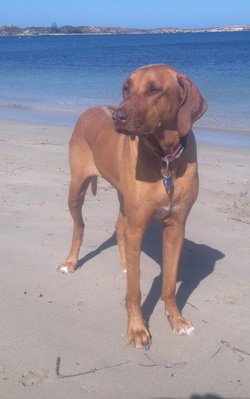
We go for walks in our neighbourhood and I often take her lead off in the quiet areas. Being the dog trainer I am, it has become natural for me to combine teaching with just about anything we do together. Walks are no exception. I have a treat pouch pretty much growing out of my hip. Which is not such a bad thing because many times I never use it. That fact alone has meant it hasn’t become the motivator for getting behaviour. Just because I’m wearing a treat pouch doesn’t mean what we are doing is any more special or urgent than when I am not wearing one. It’s not even a guarantee of treats. It means I don’t have a dog who goes nuts every time they see the treat pouch going on. Zuri doesn’t go into “train me” mode at the sight of a treat pouch. It’s a neat thing.
So, our walks are usually meandering investigations of the streets, parks and beaches of our local area with little requests of certain behaviours thrown in from me. One of my favourites is the “wait” at every roadside curb. It started with planned training and has now progressed to a point where I don’t ask her to “wait”, she does it automatically without clicker or food reinforcement. The continuing walk has become the reinforcement. Here’s how we started.
https://www.youtube.com/watch?v=y4qgQabhYKs
Then something unusual began happening on our walks. She would wait at the roadside while I crossed but when I said “OK”, she wouldn’t cross. She just stood there looking at me. It even happened when I called her into a park. She loves zoomies in the park. What on earth was going on? I tried to prompt her, made it look really exciting. Nothing.
Now this is where perception – that is, how we view our dog’s behaviour – can have a huge impact on our behaviour and our relationship with our dog.
I don’t know what’s going on in Zuri’s head. I can only see her behaviour and make assumptions on what may or may not be going on inside. There are many ways I could view this behaviour of not coming across the road when I say “OK”. Here’s a few (you could probably come up with others);
* She’s being wilfully disobedient. She knows what I want and is deliberately disobeying me. If I believe this, what do you think my subsequent behaviour will be? I would probably give her a few more chances to come, then go back and put her lead on and force her to come across the road.
* She’s asserting her dominance and testing me to see if she can rank higher. Well, she’s not going to get away with that! If I thought that, I’d probably force her to do what I asked.
* She doesn’t want to go to the park. She wants to walk somewhere different today. I guess I can choose whether what she wants trumps what I want and behave accordingly.
* She’s being cheeky. She is getting a bit a giggle out of seeing how long she can just stare at me before I come back. I guess I could chuckle along with her or get a bit annoyed.
What I think is going on in her head really could be what is going on in my head, not necessarily what is going on in hers. It can change the way I feel about her, whether I feel closer to her or annoyed. It’s actually not very helpful to try and get too far into a dog’s thoughts.
This behaviour made me curious. What would she do if I walked back over to her and walked in a different direction. So I did it. She trotted happily along when I started moving in the direction she had previously looked a few times. I tried crossing the road again to the park and she wouldn't come. When I returned to her, she was happy to continue along the footpath.
Most times, she comes. Sometimes she doesn't. When I go back to her she is happy to go another way. Could it be that dogs have likes and dislikes? Could they have preferences on different days as to whether they’d like a zoomie in the park or a sniff of the side-walk? Could all the training she has been given have opened up a way to have a dialogue with me that I might understand, so that she can convey these preferences at certain times? (Yes, it sounds like I'm getting into her head, but stick with me here).
Interestingly, she is off lead, so if she wanted to go a different way, she could just….well….go. She doesn't have a history of punishment for running off, so there’s nothing to be scared of if she just blew me off and walked where ever she wanted. The worst that would happen is that I’d follow and put the lead on – well, I guess technically that is punishing! She looks at me, waits for me and then follows when I step off in a certain direction. Now you can have a bit of insight into my head, because I feel she is communicating with me. I think she is letting me know what is reinforcing for her on particular walks.
The other interesting thing is that if I don’t back down, she will come where I have indicated without any force required.
Here’s what one of our recent walks looked like.
https://www.youtube.com/watch?v=LK2cKI3zVyc
What I do know is that I appreciate this behaviour very much. I appreciate that she doesn’t run away without me if she doesn’t want to follow. I appreciate that she will seem to put in her veto of the direction I am travelling, yet still acquiese to my desire in the end if I persist. I only need to persist gently. I don’t have to drag her or get angry. She simply responds to my voice. I appreciate that this behaviour reminds me that we’re on this walk mainly for her, not just for me to drag her around where ever I want.
Back to perception. I feel closer to her, I appreciate her and I even feel that she likes my company because of the way I perceive this behaviour as communication rather than disobedience. I enjoy trying to figure out what she is attempting to convey. If I felt she was being stubborn or status seeking, I wouldn’t have such feelings. I might even feel annoyed and a sense of disliking her on these occasions. I may feel the need to compete with her for leadership rather than the sense of being a partnership.
It may seem like I’m contradicting myself by saying don’t try and get into a dog’s head and then I seem to get into my own dog’s head by talking about her preferences on walks. If it causes no harm and has the potential to enhance the human-dog bond, I’m not as pendantic as those instances where the dog may suffer as a result. If the dog suffers, the relationship usually suffers.
I’m looking forward to tomorrow’s walk. I wonder where Zuri would like us to go.


 RSS Feed
RSS Feed